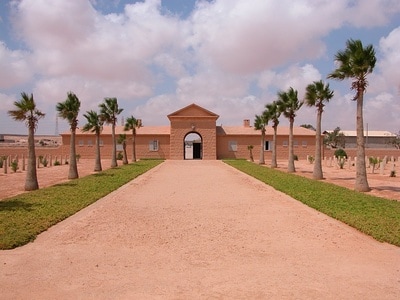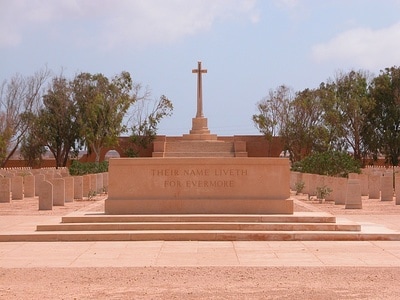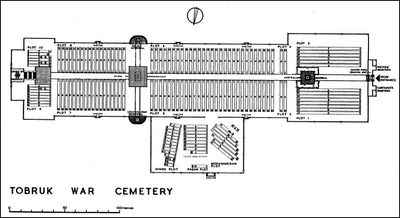TOBRUK WAR CEMETERY
Tobruk
Libya
Location Information
Tobruk is a sea port on the Mediterranean coast. Leaving the port of Tobruk on the main road to Alexandria, Tobruk War Cemetery is located about 7 kilometres inland, set back about 100 metres along an access track branching from the left side of the road, and clearly visible from the road.
Visiting Information
NOTE: Visitors to Libya may wish to note that a major renovation programme is planned for a number of our cemeteries in the country. Headstones and other features, which have become eroded over time by the harsh climate, are scheduled for replacement. Further details will be made available shortly. We apologise for any inconvenience and we would respectfully ask visitors to be patient with us while this work is ongoing.
Before considering a visit to Libya the Commission strongly recommends that you check the advice given by the Foreign & Commonwealth Office on the travel section of their website:
www.fco.gov.uk/en/travel-and-living-abroad/travel-advice-by-country/
Tobruk War Cemetery is open from 08:00 - 17:00. During these times the gardeners are present in the cemetery.
Wheelchair access to the cemetery is possible via the main entrance.
Historical Information
Tobruk is a Mediterranean port with an excellent deep water harbour. During the war it was important to Allied and Axis forces alike, for the reception of supplies and reinforcements. In January 1941, it was taken from the Italians by General Wavell's forces, and after the clearance of the demolitions in the harbour the port was usable and proved invaluable. When Rommel commenced his drive across Cyrenaica towards Suez it was deemed essential that Tobruk be held, and the resulting siege lasted from 11 April to 10 December 1941, when the Axis forces were driven back. They recovered far more quickly than was expected and by early February 1942, it was the Allies turn to fall back towards a line running southwards from Gazala to Bir Hakeim. Again orders were given to hold Tobruk, but it fell to Rommel on 21 June. It was retaken five months later by the Eighth Army in their final sweep along the North African coast into Tunisia.
Tobruk War Cemetery incorporates the burial ground used during the siege and the memorial erected there at the time by the Australians has been replaced by a permanent memorial of similar design. Many battlefield graves in the desert have been brought into the cemetery.
There are now 2,282 Commonwealth servicemen of the Second World War buried or commemorated in Tobruk War Cemetery. 171 of the burials are unidentified but special memorials commemorate a number of casualties known or believed to be buried among them. The cemetery also contains 171 war graves of other nationalities, most of them Polish.
The cemetery was designed by Sir J. Hubert Worthington, with some additional stone work provided by Sir Charles Wheeler.
Cemetery pictures used with the permission of the Commonwealth War Graves Commission
Tobruk is a sea port on the Mediterranean coast. Leaving the port of Tobruk on the main road to Alexandria, Tobruk War Cemetery is located about 7 kilometres inland, set back about 100 metres along an access track branching from the left side of the road, and clearly visible from the road.
Visiting Information
NOTE: Visitors to Libya may wish to note that a major renovation programme is planned for a number of our cemeteries in the country. Headstones and other features, which have become eroded over time by the harsh climate, are scheduled for replacement. Further details will be made available shortly. We apologise for any inconvenience and we would respectfully ask visitors to be patient with us while this work is ongoing.
Before considering a visit to Libya the Commission strongly recommends that you check the advice given by the Foreign & Commonwealth Office on the travel section of their website:
www.fco.gov.uk/en/travel-and-living-abroad/travel-advice-by-country/
Tobruk War Cemetery is open from 08:00 - 17:00. During these times the gardeners are present in the cemetery.
Wheelchair access to the cemetery is possible via the main entrance.
Historical Information
Tobruk is a Mediterranean port with an excellent deep water harbour. During the war it was important to Allied and Axis forces alike, for the reception of supplies and reinforcements. In January 1941, it was taken from the Italians by General Wavell's forces, and after the clearance of the demolitions in the harbour the port was usable and proved invaluable. When Rommel commenced his drive across Cyrenaica towards Suez it was deemed essential that Tobruk be held, and the resulting siege lasted from 11 April to 10 December 1941, when the Axis forces were driven back. They recovered far more quickly than was expected and by early February 1942, it was the Allies turn to fall back towards a line running southwards from Gazala to Bir Hakeim. Again orders were given to hold Tobruk, but it fell to Rommel on 21 June. It was retaken five months later by the Eighth Army in their final sweep along the North African coast into Tunisia.
Tobruk War Cemetery incorporates the burial ground used during the siege and the memorial erected there at the time by the Australians has been replaced by a permanent memorial of similar design. Many battlefield graves in the desert have been brought into the cemetery.
There are now 2,282 Commonwealth servicemen of the Second World War buried or commemorated in Tobruk War Cemetery. 171 of the burials are unidentified but special memorials commemorate a number of casualties known or believed to be buried among them. The cemetery also contains 171 war graves of other nationalities, most of them Polish.
The cemetery was designed by Sir J. Hubert Worthington, with some additional stone work provided by Sir Charles Wheeler.
Cemetery pictures used with the permission of the Commonwealth War Graves Commission
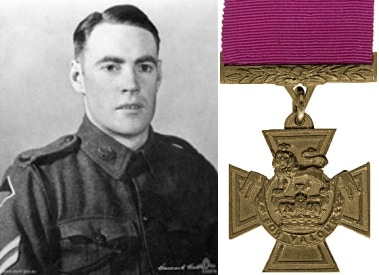
NX15705 Corporal John Hurst Edmondson, V. C.
2/17 Bn. Australian Infantry, A. I. F., died 14th April 1941, aged 26. Plot 3. J. 8.
Son of Joseph William and Maude Elizabeth Edmondson, of Liverpool, New South Wales, Australia.
Citation: The citation in the London Gazette of the 1st July, 1941, gives the following details : On the night of 13th-14th April, 1941, a party of German infantry broke through the wire defences of Tobruk, and established themselves with numerous machine guns, mortars and field pieces. Led by an officer, Corporal Edmondson and five privates carried out a bayonet charge upon them under heavy fire. Although wounded in the neck and stomach Corporal Edmondson not only killed one of the enemy, but went to the assistance of his officer, who was attacked by a German from behind while bayoneting another who had seized him about the legs. Despite his wounds, from which he later died, Corporal Edmondson succeeded in killing these two Germans also, thus undoubtedly saving his officer's life. Throughout the operation he showed outstanding resolution and leadership, and conspicuous bravery.
2/17 Bn. Australian Infantry, A. I. F., died 14th April 1941, aged 26. Plot 3. J. 8.
Son of Joseph William and Maude Elizabeth Edmondson, of Liverpool, New South Wales, Australia.
Citation: The citation in the London Gazette of the 1st July, 1941, gives the following details : On the night of 13th-14th April, 1941, a party of German infantry broke through the wire defences of Tobruk, and established themselves with numerous machine guns, mortars and field pieces. Led by an officer, Corporal Edmondson and five privates carried out a bayonet charge upon them under heavy fire. Although wounded in the neck and stomach Corporal Edmondson not only killed one of the enemy, but went to the assistance of his officer, who was attacked by a German from behind while bayoneting another who had seized him about the legs. Despite his wounds, from which he later died, Corporal Edmondson succeeded in killing these two Germans also, thus undoubtedly saving his officer's life. Throughout the operation he showed outstanding resolution and leadership, and conspicuous bravery.
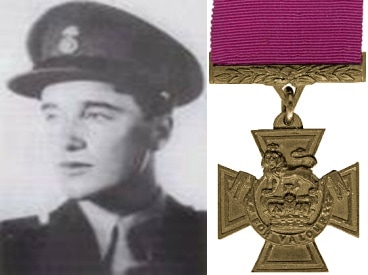
69102 Captain James Joseph Bernard Jackman, V. C.
Royal Northumberland Fusiliers, died 26th November 1941, aged 25. Plot 7. H. 9.
Son of Dr. James Joseph Jackman, M.D., and Elizabeth Frances Jackman, of Glenageary, Co. Dublin, Irish Republic.
Citation: The citation in the London Gazette of the 27th March, 1942, gives the following details: On November 25th, 1941, Captain Jackman was in command of a machine gun company of the Royal Northumberland Fusiliers in the tank attack on El-Duda Ridge, south-east of Tobruk. The tanks were met by such heavy and intense fire that it seemed doubtful whether the brigade could hold the position. In the front they were assailed by the batteries they were attacking, and on their flanks by anti-tank guns. Captain Jackman calmly and rapidly got his guns into action and secured the right flank. Then, standing up in his truck he led the other trucks across the front between the tanks and the guns to get them into action on the left flank. Coolly directing the guns to their positions and indicating to them their targets, he seemed at that time to bear a charmed life, but later on he was killed. Throughout the attack Captain Jackman showed outstanding gallantry, and devotion to duty above all praise. His magnificent bearing, inspiring his men with confidence and the tank crews with determination not to relinquish the position they had gained, contributed in a large measure to the success of a most difficult and hard fought action.
Royal Northumberland Fusiliers, died 26th November 1941, aged 25. Plot 7. H. 9.
Son of Dr. James Joseph Jackman, M.D., and Elizabeth Frances Jackman, of Glenageary, Co. Dublin, Irish Republic.
Citation: The citation in the London Gazette of the 27th March, 1942, gives the following details: On November 25th, 1941, Captain Jackman was in command of a machine gun company of the Royal Northumberland Fusiliers in the tank attack on El-Duda Ridge, south-east of Tobruk. The tanks were met by such heavy and intense fire that it seemed doubtful whether the brigade could hold the position. In the front they were assailed by the batteries they were attacking, and on their flanks by anti-tank guns. Captain Jackman calmly and rapidly got his guns into action and secured the right flank. Then, standing up in his truck he led the other trucks across the front between the tanks and the guns to get them into action on the left flank. Coolly directing the guns to their positions and indicating to them their targets, he seemed at that time to bear a charmed life, but later on he was killed. Throughout the attack Captain Jackman showed outstanding gallantry, and devotion to duty above all praise. His magnificent bearing, inspiring his men with confidence and the tank crews with determination not to relinquish the position they had gained, contributed in a large measure to the success of a most difficult and hard fought action.

5440304 Corporal
John Edward Trestrail Maynard
Duke of Cornwall's Light Infantry and No. 8 Commando
Between 17th July 1941 and 18th July 1941, aged 24.
Plot 4. K. 10.
Son of Percy Castell Maynard and Mary Elizabeth Maynard, of Redruth, Cornwall. Awarded the Royal Humane Society's Testimonial in Vellum, for Saving Life at Sea, 17th August, 1939.
John Edward Trestrail Maynard
Duke of Cornwall's Light Infantry and No. 8 Commando
Between 17th July 1941 and 18th July 1941, aged 24.
Plot 4. K. 10.
Son of Percy Castell Maynard and Mary Elizabeth Maynard, of Redruth, Cornwall. Awarded the Royal Humane Society's Testimonial in Vellum, for Saving Life at Sea, 17th August, 1939.

